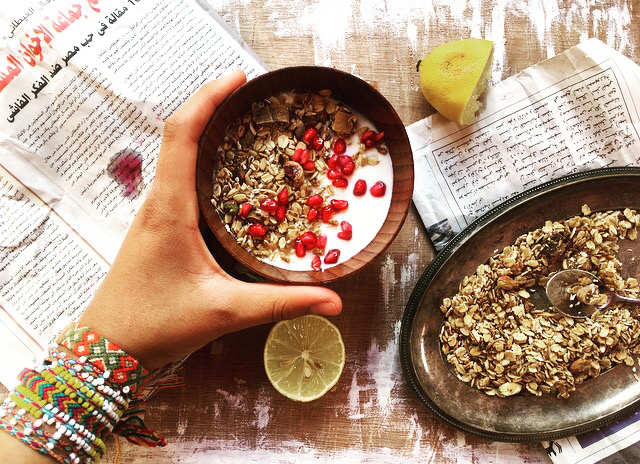This summer has been incredible. But short, as always. It’s that time of year when we have to say goodbye to our favourite season, and welcome autumn with open arms. I’ve already eaten my weight in freshly picked blackberries and I’m almost ready to go apple hunting. But before I go knee-deep pumpkins, swedes and celeriac, I want to celebrate the end of another splendid season with BIG flavour. A North-African inspired breakfast bowl, teeming with tangy goodness. Nothing can give summer a better send-off.

Moroccan recipes often require Preserved Lemons. Though they don’t look very appetising, believe it or not, they are bombs of flavour that can transform a dish completely. Preserving your own lemons is a lot easier then you may think. It’s a simple 5 minuet task, though patience is necessary – it’s a long two-month wait. For the inpatient among you, don’t fret, after two weeks you’ll taste the tang. However, I’m afraid to say that the longer you allow it to mature, the better the flavour, and the health benefits. Mine has been maturing for one year now, and the flavour is intense yet incredible.
I know we are all aware of how beneficial lemons are – extremely high levels of vitamin C, significantly rich in potassium and vitamin B6. But how often do you eat the skin? How often do you use the whole lemon? Lemon peel has a 5-10X higher nutrient profile then the juice itself. So, just to give you a brief idea – the high levels of potassium in the peel aids in reducing low density lipoproteins (bad cholesterol) in the body, maintaining healthy cholesterol levels. The peel is also rich in calcium (100g contains 134mg – USDA National Nutrient Database), necessary for skeletal structure, nerve cell function and cell signalling. And finally, vitamin C – the ruler of immunity and ‘good skin’. Well, it’s not completely an urban myth! Vitamin C does in fact play a role in the production of collagen – a protein used to make skin, cartilage, blood vessels, tendons and ligaments.
This recipe requires whole lemons (peel and all) to be fermented. As if the nutrient-rich lemon peel wasn’t good enough already, it’s been through the process of lacto fermentation. Making it yet even more beneficial – enzymes, probiotics, B vitamins and omega-3 fatty acids.

To top it all off (literally speaking); a sprinkle glorious golden granola and sparkling pomegranate gems. This is a bowl that will get your taste buds dancing, it’s filled with flavour and amazing textures – I love biting into the pomegranate gems – crunching into the seed followed by an explosion of pink juice. They complement the tangy, velvety yogurt and crunchy spiced granola, creating something truly divine.
Recipe
For the fermented lemons (Makes 1 Jar):
- 5 organic unwaxed lemons
- 1 tbsp salt
For the Granola (Makes 2 Large Jars):
- 750g jumbo oats
- 50g coconut palm sugar
- 4 tbsp coconut oil (melted)
- 10 cardamom pods (blended to a fine powder)
- Seeds of 5 cardamom pods
- 120g pistachios (chopped)
- 120g organic dried figs (chopped)
- 100g desiccated coconut (optional)
For the Yogurt (Serves 2):
- 300g soya yogurt
- 1/4 fermented lemon
- dash of soya milk
- 200g granola
- pomegranate gems, to serve
Method
For the Fermented Lemons:
- Sterilise a jar with boiling water
- Wash and cut your lemons into quarters
- In layers, add lemon quarters and sprinkles of salt. Using the end of a rolling pin, squash the lemons so that all the juice comes out. The aim is to compress all the lemon quarters into the jar and have them completely submerged in their own juice (just like when compressing sauerkraut). The absence of air will ensure that pathogens cannot grow.
- Leave in a warm dark place for 2 months +, when the skin is completely soft, then they’re ready to consume.
For the Granola:
- Preheat the oven at 180
- Put the oats, pistachios, figs, and coconut (if using) in a bowl and mix.
- Coat the dry mix with the melted coconut oil, then add the ground cardamom pods and coconut sugar. The coconut oil will allow the sugar and powder to stick to the to mix.
- Place onto a flat baking tray and bake for 35-45 mins, stirring every 10 mins (watch out of the edges, they brown quickly!
- Remove from the oven and allow to cool – It’s the cooling process which allows the coconut sugar to crystallise and make the granola crunchy. When cool, stir in the cardamom seeds for extra bursts of flavour.
- Store in an airtight container.
For the yogurt:
- Simply blend all the ingredients together, forming a smooth tangy yogurt. Add more or less soya milk to achieve your desired consistency.
- Top with granola and pomegranate gems and let the flavours work their magic!






Leave a comment